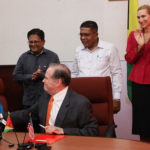The National Agriculture Research and Extension Institute (NAREI) is working with farmers to reduce the effects of the red palm mite while at the same time, looking at means of eliminating it completely.
This pest feeds on the leaves of over 30 species of palms including the coconut, and bananas, ginger and other crops. It is about one-hundredth of an inch in length, bright red in colour, and are found on the underside of leaves.
NAREI is currently conducting studies, research and experiments to create natural enemies which are environmentally friendly insects that will feed off of the palm mite. Research Assistants are currently grooming and mating these insects in the entomology labs, to create an environmentally friendly control method for the mites. On completion of the experiment, an evaluation exercise is carried out in a shade house.
NAREI’s Chief Executive Officer (CEO), Dr. Oudho Homenauth, told the Government Information Agency (GINA) that “late last year the Government…following our visit to the Pomeroon and meeting with the farmers would have made available $49M to assist coconut farmers in managing the red palm mite.”
He explained that, “the focus was on ensuring that all farmers would have access to the chemicals to manage the mite. Also training was provided on how to apply it …. We would have gone a far way in this exercise, not only in the Pomeroon, but in all other coconut growing areas.”
The exercise includes the use of these chemicals to kill the mites; however, the process takes a long period to show its effect. Farmers are advised not to apply treatment on their own because it can affect their health, damage crops and the environment as well.
Farmers have been praising NAREI’s efforts saying they have helped to “increase production, while the mites had reduced significantly.” An average farmer has seen a reduction of over 500 coconuts per acre due to the mites’ infestation.
All farmers who observe their coconut tree leaves falling off, or a find a red substance on their fingers or tissue after wiping the underside of the coconut branches are asked to contact NAREI, or an extension officer who will investigate and then provide assistance.
The red palm mite was first located in the Middle East and South East, Asia and is now establishing itself in the Caribbean.





